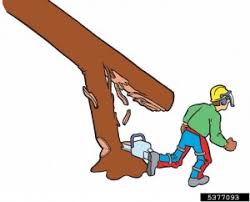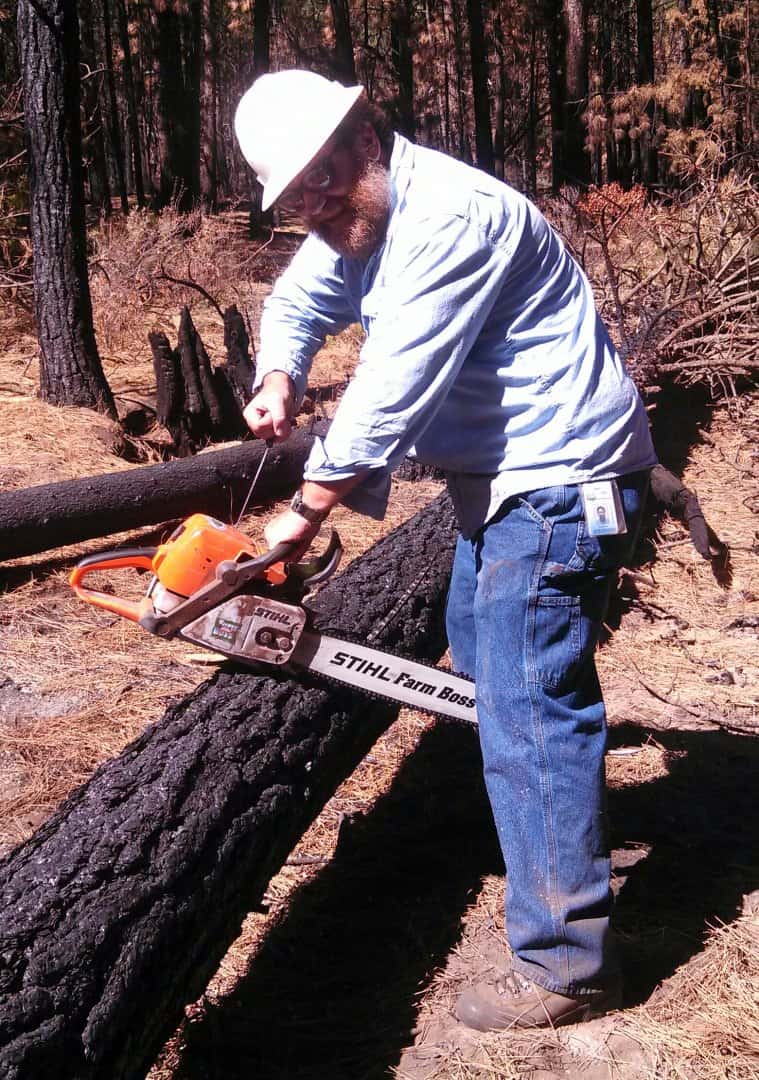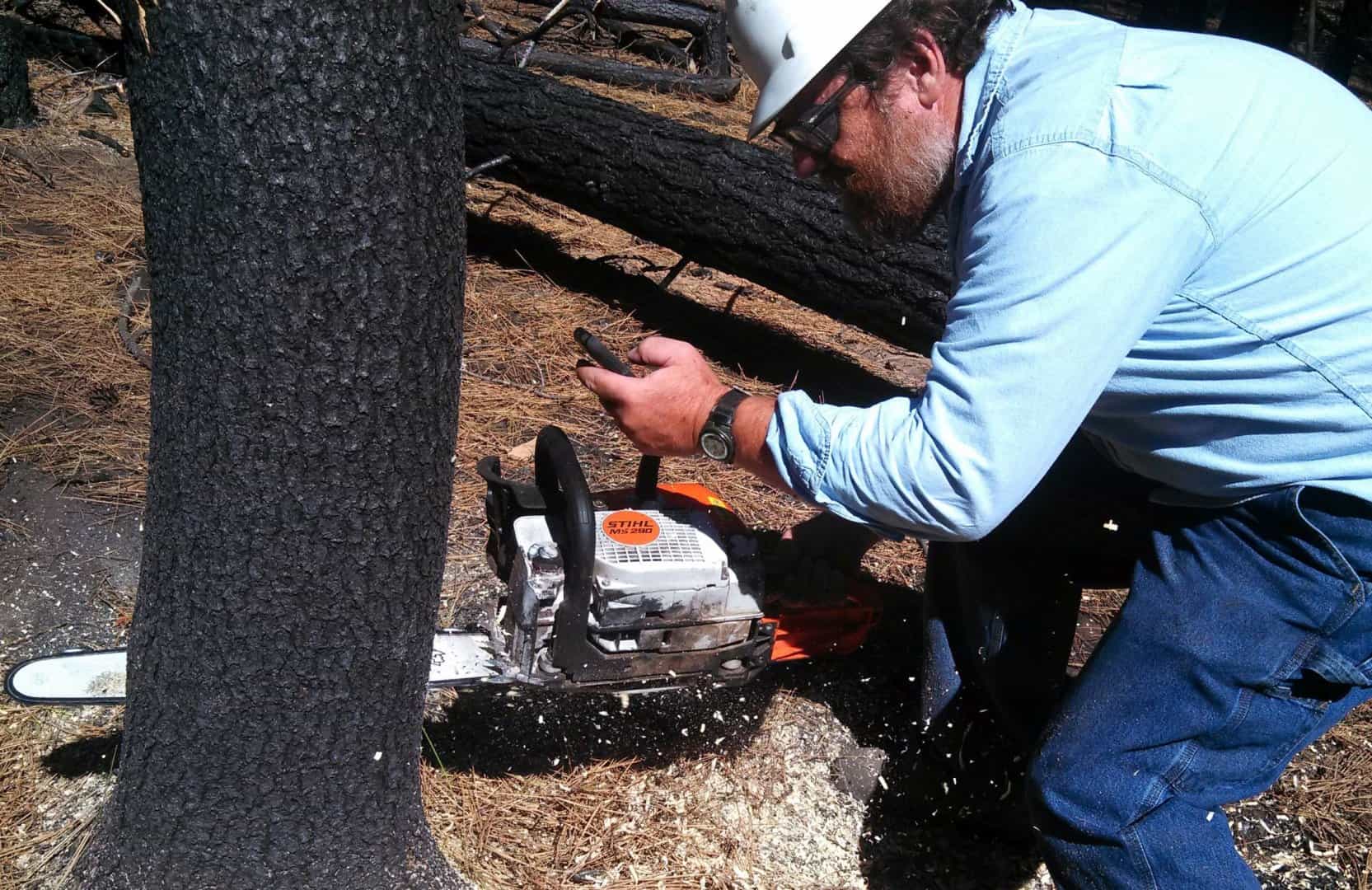It depends, too, maybe, on how big the trees are; that are in your way.:

A couple of advanced tricks. If falling a tree sideways to the lean, plunge a couple of Idaho cuts on each side of the hinge. These are vertical cuts that parallel the hinge and are performed by boring the saw bar straight into the tree. What this achieves is it creates a longer hinge length in the vertical direction which is more flexible. This allows the hingewood to control the direction of the fall longer before it breaks due to bending of the hinge.
Another trick to get a tree to fall in a direction and then swing to one side, is to cut a Dutchman. This is basically a triangular shaped section of holding wood on one side of the stump, with the other side cut clear through. It is successful in some species more than others. Strong but limber bull pine (young ponderosa) is one example.
clearcut, post: 451307, member: 297 wrote: I'd have to disagree. I personally know quite a few dead timberfellers.
Survey line clearers or Loggers? I've never personally heard of any cases of Surveyors being injured out felling trees. They were always cutting line. Lots of injuries cutting small diameter trees. Usually the tree fallers get hurt riding the butt out of the hole.
Surveyors shy away from cutting down large diameter trees. It slows down production and is hard work.
You might of knew some dead tree fallers, but I doubt if you know any of them any more.
The guy's a Surveyor, not a logger. A plunger cut is a fast way for a beginner to get killed. You're in the wrong Forum. This is a Surveyor's Forum, not a Logger Forum.
I??ve spent most of my 35 year career mark and posting true line. Most of that using 3 crews. Most of that using 024 and 026 Stihls in very brushy and steep country. As a part-time ??hobby? I log and sawmill. Logging is a small part of my career but I was taught by the best.
In all that time our crews have been brushing line we have had but just a couple of minor injuries.
I can also tell you with authority it doesn??t take a very big tree to hurt or kill you. Felling trees is a far more dangerous endeavor. Big or small.
And most loggers are not hurt riding them out.
clearcut, post: 451304, member: 297 wrote: As a long time timber feller I would advise otherwise. As the tree tips and has its momentum headed where the hinge has directed it, it is actually important to stay with the stump and clear the hingewood off before the undercut closes. This will prevent the tree from barber-chairing. Barber-chairs kill. The other advantage is that it eliminates stump pullage/splintering. This is important for maximum lumber production and adds greatly to the mill's bottom line.
I agree that as much of the hinge wood should be cut as possible as the tree is falling to build momentum so it does not hang up in other trees. I don't usually get all the way through before heading for safety.
clearcut, post: 451306, member: 297 wrote: In this picture, the face cut is upside down from that of a what a true timberfeller would cut. The face cut should be an undercut with the slant being downward not upward. Plus the back cut is best aligned perfectly with the horizontal cut of the face cut. This will result in a nice square log end which is optimal for lumber production.
I typically cut reverse to what is shown in that picture as well. Not because of waste, but just because that is how I was taught.
I have seen some pretty funky looking stumps in the woods and I know there are various ways to fall leaning trees in a direction other than how they are leaning.
clearcut, post: 451325, member: 297 wrote: I??ve spent most of my 35 year career mark and posting true line. Most of that using 3 crews. Most of that using 024 and 026 Stihls in very brushy and steep country. As a part-time ??hobby? I log and sawmill. Logging is a small part of my career but I was taught by the best.
In all that time our crews have been brushing line we have had but just a couple of minor injuries.
I can also tell you with authority it doesn??t take a very big tree to hurt or kill you. Felling trees is a far more dangerous endeavor. Big or small.
And most loggers are not hurt riding them out.
Doesn't take but a short piece of silver limb to put a lethal dent in the top of your head. I always scan the canopy for hung up limbs before falling a tree.
A long time ago a friend and I fell a 6 foot diameter tree across the road. Was a joint effort getting the cuts aligned properly. When we got back down to the road, we panicked at how much lumber was blocking the road. I remember rolling a handful of 5 foot dia. wheels out and that was over a cord. There still was not enough room for a truck to pass, so we cut a few more out and left them along the road. We went back and got 5 more cords out of that tree.
Now you would go to jail over something like that.
I always thought it was easier to avoid the trees - at least the large ones - when traversing.
R.J. Schneider, post: 451454, member: 409 wrote: I always thought it was easier to avoid the trees - at least the large ones - when traversing.
20 years ago, many surveyors would run true line between corners and cut windows through any tree they didn't cut down.
That way the brushing they did was actually quite close to the line they were hired to brush/mark.
That practice is now frowned upon and people run random traverses as close to the calculated line as possible and pull offsets from each traverse point.
R.J. Schneider, post: 451454, member: 409 wrote: I always thought it was easier to avoid the trees - at least the large ones - when traversing.
Much of my first 15 years surveying was spent retracing whole townships in steep, brushy and heavily timbered terrain. We also used helicopters extensively.
In order to create helipads and to facilitate long traverse shots, we often had to fell a fair amount of trees as part of our day to day work. Mostly oaks as the timber companies were OK with us cutting those down of any size as it is considered a non-merchantable species here. But we also cut a fair amount of medium sized conifer on occasion.
imaudigger, post: 451497, member: 7286 wrote: 20 years ago, many surveyors would run true line between corners and cut windows through any tree they didn't cut down.
That way the brushing they did was actually quite close to the line they were hired to brush/mark.
Face Blaze. The larger tracts I've surveyed had face blazes for line trees if they were there.
R.J. Schneider, post: 451548, member: 409 wrote: Face Blaze. The larger tracts I've surveyed had face blazes for line trees if they were there.
That's how we did it.
In the past, they would shove the chunk back into the "window" and it would pitch over and leave a scar on both faces (if it didn't kill the tree).
Is that known as an Oregon vasectomy?
We use fire crews for serious line cutting
BUT
you have to tell them it's not fire line otherwise they will clear a 10' wide swath down to bare earth, with a trail down the middle.






